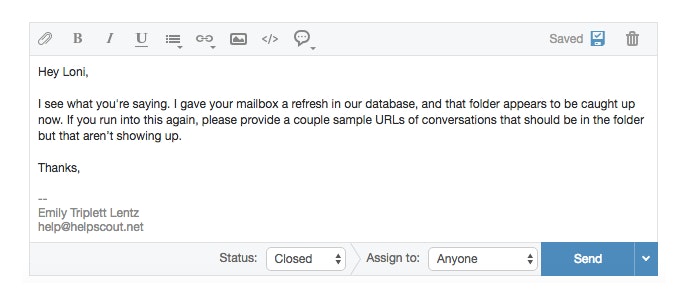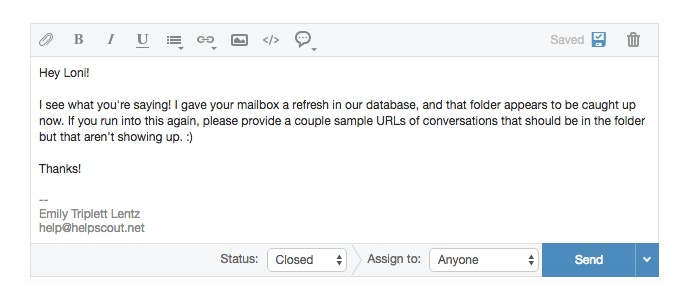Concerned that using exclamation points and emoticons in your customer support correspondence will come across as frivolous or unprofessional? Don’t be. Research shows that subject matter experts who use emoticons are perceived as more “friendly and competent” than those who don’t.
In most cases, you can create a more positive customer experience simply by dressing up your communication with punctuation.
Why overt friendliness works in written customer communications
Consider the following two support emails, identical except for the use of exclamation points and emoticons:


Compared to the second email, the first almost sounds like I’m irritated the customer got in touch, doesn’t it?
Face to face, messages like these don’t require such explicit friendliness (you wouldn’t grin at a customer two feet in front of you and shout “I see what you’re saying!), because tone and body language convey meaning that text alone does not.
Without that extra meaning, email suffers from the negativity effect, wherein the recipient interprets the message as more negative than the sender intended.
Additional cues, like exclamation points and emoticons, can help the sender convey a positive tone the recipient may not otherwise assume.
For those who worry that these friendly overtures may come across as frivolous or unprofessional, additional research shows that subject matter experts who use emoticons are perceived as more “friendly and competent” than those who don’t.
Experimenting with exclamation points
Help Scout’s Mathew Patterson, who formerly led the support team at Campaign Monitor, had team member Tash Tiliacos comb through previous customer conversations in search of the correlation between positive feedback and exclamation points and emoticons. Of the conversations that resulted in a “10 out of 10” rating, Tiliacos found that 67 percent contained at least one exclamation point, 20 percent included multiple exclamation points, and 23 percent included both an exclamation point and a “:)” emoticon.
After that finding, the “less naturally exclamatory” people on the team agreed to try adding more exclamation points to their responses. “We saw those people improve their overall customer ratings in the following month,” Mat says.
Read the room: Different styles for different contexts

A word of caution: Exclamation points and emoji aren’t for everyone. I rarely use a smiley face in a support email when the customer’s signature includes “PhD,” for example — not that academics are humorless, just that “:)” isn’t likely to get you taken seriously by someone who spent five years deconstructing utopian undertones in nineteenth-century fictional autobiography.
Read the incoming email for cues (Is the customer using formal or relaxed language? Are they angry or do they just have a question?), and reply accordingly. Andrew Brodsky from Harvard Business Review writes:
One strategy that has been found to be very effective across settings is to engage in behavioral mimicry (i.e., using emoticons, word-choice, and slang/jargon in a similar manner to the person with whom you are communicating). This process of mimicry increases trust because people tend to feel an affinity toward those who act similarly to them.
If your customer initiates the conversation with a greeting like “Hey folks!” that’s a good indication you can exclaim and emote to your heart’s content in your reply … and perhaps even include your favorite corgi gif.
Adapting your communication style
I come from a corporate communications background where there was little room for fluff or personal expression. Style guides reigned supreme and sentences were intended to convey information, not emotion. Emoji? Forget it. Even exclamation points were practically vulgar. (My favorite editor, on the subject of exclamation points, used to say “You get one per year.”)
So when I first joined the Basecamp support team I assumed customers would appreciate concise responses that answered their questions with minimal fuss and maximal professionalism.
My CSAT scores weren’t in the toilet, exactly, but they weren’t as high as the rest of the team’s. A teammate encouraged me to use more exclamation points and smiley faces in my customer interactions and to start friendly-ing up my replies with phrases like “Great idea!” and “Happy Tuesday!”
I didn’t wanna. It felt contrived and unnatural, and I fretted customers would be insulted by the assumption of familiarity. But I was at least aware that different contexts call for different communication styles, and I started experimenting with using more exclamation points and emoticons. In a finding that should surprise no one by now, my CSAT scores rose.
Unless your enterprise inherently connotes seriousness — say, wealth management or funeral services — your written customer communication can probably benefit from a friendly emoji and an exclamation point or two. Run your own experiment: How do your customers respond when you convey unmistakable happiness to hear from them?
You know where our money is :)


